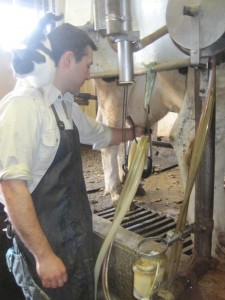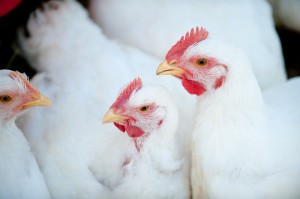I grew up on a dairy farm, and I did not want to be dairy farmer. Yet that now (though in different ways) is what I’m setting out to do.
 My predominant childhood experience of dairy farming was of my father working long hours (he’d start the work day at 4:30am and end it at 8:30pm, with just a few too-short breaks for breakfast and lunch), seven days a week (he’d occasionally get off Sunday morning to sleep in), for too-little pay (his salary was pretty much in line with a 40-hour week minimum wage job, plus housing, for a give-or-take 80 hour workweek—in a good year). Never mind the back aches, the hurt shoulder, the leg pains, and the loss of hearing. A big part of the pay issue is that we would get too-little money for our milk, because in large part the market was saturated. Why grow and produce something that is not wanted or needed? Something that took a lot of time, energy, fuel, and chemicals to produce?
My predominant childhood experience of dairy farming was of my father working long hours (he’d start the work day at 4:30am and end it at 8:30pm, with just a few too-short breaks for breakfast and lunch), seven days a week (he’d occasionally get off Sunday morning to sleep in), for too-little pay (his salary was pretty much in line with a 40-hour week minimum wage job, plus housing, for a give-or-take 80 hour workweek—in a good year). Never mind the back aches, the hurt shoulder, the leg pains, and the loss of hearing. A big part of the pay issue is that we would get too-little money for our milk, because in large part the market was saturated. Why grow and produce something that is not wanted or needed? Something that took a lot of time, energy, fuel, and chemicals to produce?
So I went off to college, intending to become a science teacher. Four years later, I graduated with a BA in Religious Studies and Philosophy (yes, you read that right) and was married to a pretty swell gal named Sarah. Of note, when she first found out I lived on a farm, she thought that was great. I thought she didn’t know the half of it, simply a naïve non-farmer with romantic and idyllic perceptions of a farm. Together we set of for Selma, Alabama to volunteer for a year with an Americorps-type program, the Edmundite Missions Corps.
 Part of my duties in the program involved working with a small non-profit farm connected with Heifer International. That is when I first learned of Something Good about farming. The mission of Heifer Int’l “is to work with communities to end hunger and poverty and care for the Earth,” which is done by providing communities with livestock, teaching sustainable methods of farming, and connecting these farmers with markets. In Heifer’s words, “By giving families a hand-up, not just a handout, we empower them to turn hunger and poverty into hope and prosperity, but our approach is more than that. By bringing communities together and linking them with markets in their area, we help bring sustainable agriculture and commerce to areas with a long history of poverty.”
Part of my duties in the program involved working with a small non-profit farm connected with Heifer International. That is when I first learned of Something Good about farming. The mission of Heifer Int’l “is to work with communities to end hunger and poverty and care for the Earth,” which is done by providing communities with livestock, teaching sustainable methods of farming, and connecting these farmers with markets. In Heifer’s words, “By giving families a hand-up, not just a handout, we empower them to turn hunger and poverty into hope and prosperity, but our approach is more than that. By bringing communities together and linking them with markets in their area, we help bring sustainable agriculture and commerce to areas with a long history of poverty.”
I saw, then, that farming was not, or rather need not be, simply a job of some sort, but could be and do something good for people.
 More specifically, the Heifer project with which I was working was focused primarily on pastured poultry and rotational grazing. Small-scale pastured poultry, with relatively low start-up costs and fair income potential through direct-markets, offered something to struggling farmers or could-be farmers in the area. Rotational and management-intensive grazing could optimize the use of (often marginal) grassland through the controlled application of ruminants like cows, goats, and sheep. Pasture under managed grazing, I learned, could be one of the most productive agricultural systems, in terms of carbon-sequestration, solar-harvesting, and in turn protein production, with little infrastructure and energy needs (basically some electric fencing and watering tanks), and with much less fuel use (no machine tillage, fertilizing, and harvesting, since the animals do all the work). I learned also, at a timely conference in Montgomery, “Grazefest,”that grass-fed meat, milk, and eggs were much healthier than their conventional, non-pastured counterparts. I quickly got to thinking about the potential applications of these systems to my family’s farm back in Vermont, in terms of economics, environment, and work. Turns out I was actually late in the game, as many other Vermont (and elsewhere) farmers were also in various stages of implementing such practices. Might I actually wind up back in Vermont, farming for Good?
More specifically, the Heifer project with which I was working was focused primarily on pastured poultry and rotational grazing. Small-scale pastured poultry, with relatively low start-up costs and fair income potential through direct-markets, offered something to struggling farmers or could-be farmers in the area. Rotational and management-intensive grazing could optimize the use of (often marginal) grassland through the controlled application of ruminants like cows, goats, and sheep. Pasture under managed grazing, I learned, could be one of the most productive agricultural systems, in terms of carbon-sequestration, solar-harvesting, and in turn protein production, with little infrastructure and energy needs (basically some electric fencing and watering tanks), and with much less fuel use (no machine tillage, fertilizing, and harvesting, since the animals do all the work). I learned also, at a timely conference in Montgomery, “Grazefest,”that grass-fed meat, milk, and eggs were much healthier than their conventional, non-pastured counterparts. I quickly got to thinking about the potential applications of these systems to my family’s farm back in Vermont, in terms of economics, environment, and work. Turns out I was actually late in the game, as many other Vermont (and elsewhere) farmers were also in various stages of implementing such practices. Might I actually wind up back in Vermont, farming for Good?
My work with Heifer aside, Sarah’s and my other volunteer work simply did not seem needed, and thus unrewarding. So we ended our time in Alabama early, and headed back to Vermont. This timing was perfect for my family, as my father was going in for shoulder surgery (remember those 80-hour workweeks?) and would be unable to farm for 12 weeks. So I filled in best I could, a grueling 12 weeks that sobered our thoughts of farming for a living. How easy it is for those romantic images to filter into your imagination when you’re not actually farming.
